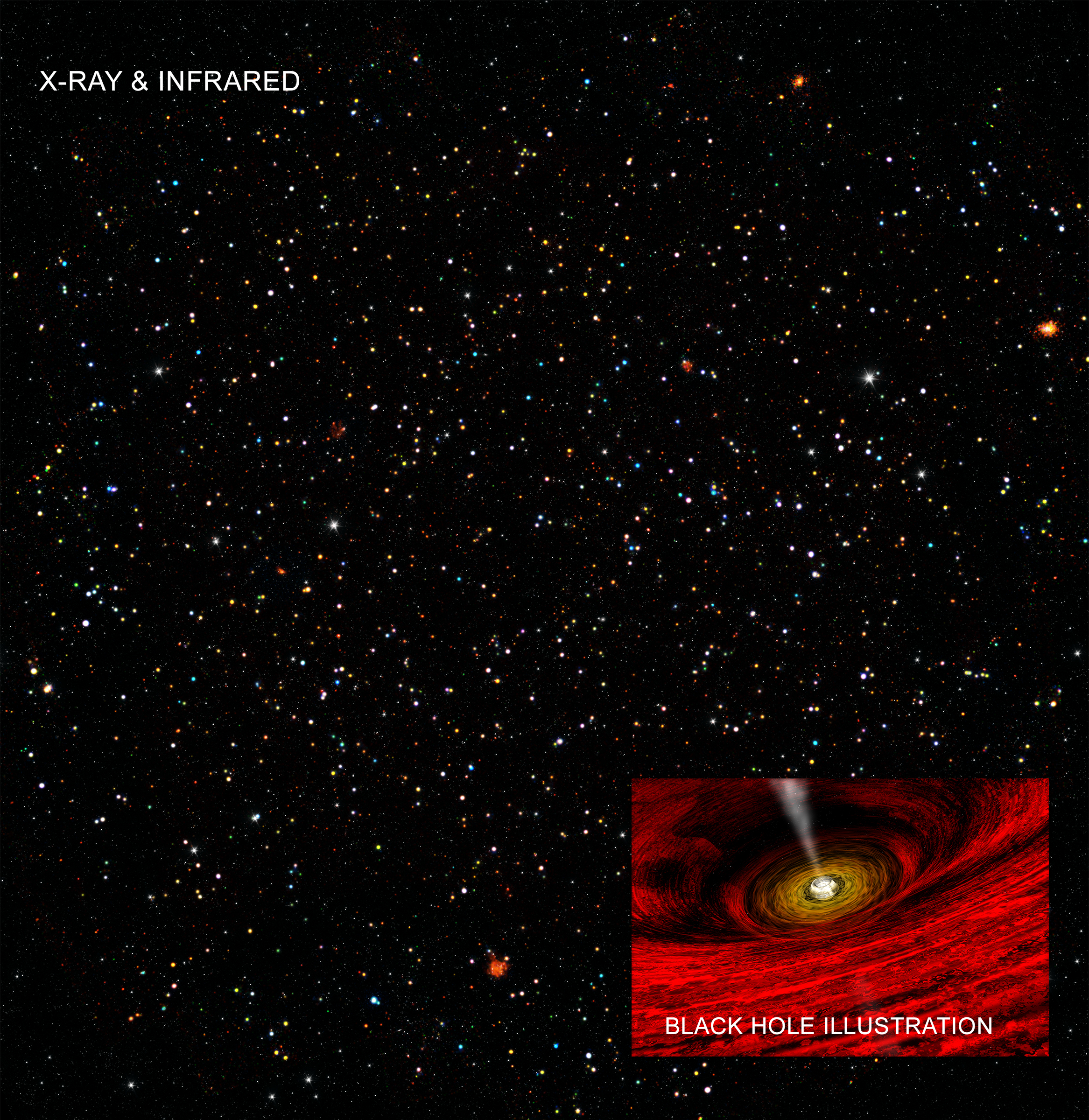Mysterious Midsize Black Holes Lurk at the Hearts of Tiny Galaxies
Scientists using NASA's Chandra X-Ray Observatory have found evidence that hundreds of possible midsize black holes lurk at the cores of smaller galaxies in the universe.
These mid-sized black holes, formally known as "Intermediate-mass" black holes (IMBHs), are notoriously elusive, yet an area of great interest because they could help astronomers better understand how some of the largest black holes in the early universe formed, according to a statement from NASA.
IMBHs contain between about a hundred and several hundred thousand times the mass of the sun. They are larger than frequently studied "stellar mass" black holes but smaller than "supermassive black holes," which can be found at the center of most galaxies.
Using the Chandra COSMOS-Legacy survey, researchers discovered a treasure trove of IMBHs in dwarf galaxies, both distant and nearby, according to the statement. The scientists detailed the results in two new studies. [The Strangest Black Holes in the Universe]
"We may have found that dwarf galaxies are a haven for these missing middleweight black holes," Mar Mezcua, a postdoctoral researcher at the Institute of Space Sciences in Spain and the lead author of one of the studies, said in the statement. "We didn't just find a handful of IMBHs — we may have found dozens."
Dwarf galaxies contain less than 1 percent the mass in stars as our Milky Way does. COSMOS (short for "Cosmic Evolution Survey") characterizes these galaxies based on data from Chandra and other telescopes, which detect X-ray emissions coming from the centers of the dwarf galaxies — "a telltale sign" that a black hole is present, according to the NASA statement.
Using this data, Mezcua and her team identified 40 growing black holes lurking in dwarf galaxies, most of which are believed to be IMBHs with masses ranging from 10,000 to 100,000 times that of the sun, according to the statement.
Breaking space news, the latest updates on rocket launches, skywatching events and more!

Twelve of the X-ray sources identified are located more than 5 billion light-years from Earth. In fact, one of the black holes discovered resides 10.9 billion light-years away, making it the most distant growing black hole ever found in a dwarf galaxy, according to the statement.
What's more, the team also identified the least-massive galaxy ever found to host a growing black hole at its core, according to that study, published Aug. 1 in the journal Monthly Notices of the Royal Astronomical Society.
Another team, led by Igor Chilingarian of the Harvard-Smithsonian Center for Astrophysics in Cambridge, Massachusetts, identified a whopping 305 possible IMBH candidates — most of which reside no more than 1.3 billion light-years away, according to the statement.
"This is the largest sample of intermediate-mass black holes ever found," Chilingarian said.
Using data from the Sloan Digital Sky Survey, the researchers studied galaxies with properties suggesting an IMBH was lurking at their core. A closer look with Chandra and the European Space Agency's XMM-Newton X-ray space observatory showed that only about half of the 305 candidates are likely to be valid IMBHs, according to the study, published Aug. 6 in The Astrophysical Journal.
"This black-hole bounty can be used to address one of the biggest mysteries in astrophysics," Chilingarian said.
Specifically, learning more about these elusive IMBHs could help astronomers better understand how supermassive black holes formed so quickly after the Big Bang. Currently, scientists think that these behemoths form either from smaller black-hole "seeds" that merge to form IMBHs, or that they grow rapidly following the collapse of giant clouds of gas that are hundreds of thousands of times the mass of the sun, according to the statement.
The two studies offer evidence that supports both of these theories. Therefore, more robust samples of black holes are needed to confirm exactly how supermassive black holes form, the researchers said.
Follow Samantha Mathewson @Sam_Ashley13. Follow us @Spacedotcom, Facebook and Google+. Original article on Space.com.
Join our Space Forums to keep talking space on the latest missions, night sky and more! And if you have a news tip, correction or comment, let us know at: community@space.com.

Samantha Mathewson joined Space.com as an intern in the summer of 2016. She received a B.A. in Journalism and Environmental Science at the University of New Haven, in Connecticut. Previously, her work has been published in Nature World News. When not writing or reading about science, Samantha enjoys traveling to new places and taking photos! You can follow her on Twitter @Sam_Ashley13.
